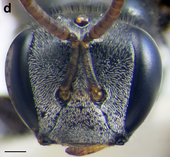Austroplebeia
| Austroplebeia | |
|---|---|
 | |
| Female Austroplebeia australis | |
| Scientific classification | |
| Domain: | Eukaryota |
| Kingdom: | Animalia |
| Phylum: | Arthropoda |
| Class: | Insecta |
| Order: | Hymenoptera |
| Family: | Apidae |
| Tribe: | Meliponini |
| Genus: | Austroplebeia Moure, 1961 |
Austroplebeia is a stingless bee (Meliponini) genus in the family Apidae. The genus was erected by Jesus Santiago Moure in 1961.[1][2] The genus comprises five described species endemic to Australia and New Guinea.[3] Austroplebeia are more closely related to the African stingless bees than rest of the species found in Asia and Australia.[4]
The species of Austroplebeia are difficult to separate reliably by body size or morphology[5] except for A. cincta which can be distinguished readily by its colouration and pilosity.[6] There are also few differences in their nest structures. This has hindered taxonomic studies to date and no workable key exists for the Austroplebeia species.[7]
All species are small, black and robust (length: 3.0–4.9 mm) and differ from other stingless bee species that co-occur in the same region (i.e. Tetragonula, Platytrigona, Papuatrigona) by the presence of cream or yellow markings in their head and thorax.[3] Most species construct their nests largely from wax, unlike most stingless bees, they use propolis sparingly. They construct a fine, lacy curtain of resin droplets over their nest entrance at night in order to protect against ants and other predators.[8][9]
In Australia, people keep these bees in logs or wooden hives made of boxes.[8][9] They show potential as pollinators of both field and greenhouse crops[10][11][12]
Species
[edit]In alphabetical order:[13]
- Austroplebeia australis (Friese, 1898)
- Austroplebeia cassiae (Cockerell, 1910)
- Austroplebeia cincta (Mocsáry, 1898)
- Austroplebeia essingtoni (Cockerell, 1905)
- Austroplebeia fujianica (Engel, 2021)
- Austroplebeia magna (Dollin, Dollin, & Rasmussen, 2015)
Gallery
[edit]- Austroplebeia worker faces
- A. cincta (New Guinea population) worker face. Scale bar = 0.25 mm
- A. cincta (Queensland population) worker face. Scale bar = 0.25 mm
- A. essingtoni worker face. Scale bar = 0.25 mm
- A. australis worker face. Scale bar = 0.25 mm
- A. cassiae worker face. Scale bar = 0.25 mm
- A. magna worker face. Scale bar = 0.25 mm
References
[edit]- ^ Moure, J.S. (1961). "A Preliminary Supra-specific Classification of the Old World Meliponine Bees (Hymenoptera, Apoidea)". Studia Entomologica. 4 (1–4). Editora Vozes: 181–242. ISSN 0585-5098. OCLC 430338837.
- ^ Michener, C.D. (21 September 1990) [1990]. "Classification of the Apidae (Hymenoptera)". University of Kansas Science Bulletin. 54 (4). Lawrence, Kan.: University of Kansas: 75–164. ISSN 0022-8850. OCLC 23011586. S2CID 82977325. BioStor BHL ResearchGate Publication 313186394
- ^ a b Dollin, Anne E.; Dollin, Leslie J.; Rasmussen, Claus (23 November 2015). "Australian and New Guinean Stingless Bees of the Genus Austroplebeia Moure (Hymenoptera: Apidae)—a revision". Zootaxa. 4047 (1): 1–73. doi:10.11646/zootaxa.4047.1.1. ISSN 1175-5334. PMID 26624733.
- ^ RASMUSSEN, CLAUS; CAMERON, SYDNEY A. (1 January 2010). "Global stingless bee phylogeny supports ancient divergence, vicariance, and long distance dispersal". Biological Journal of the Linnean Society. 99 (1): 206–232. doi:10.1111/j.1095-8312.2009.01341.x. ISSN 0024-4066.
- ^ Dollin, Anne E.; Dollin, Leslie J.; Sakagami, the late Shôichi F. (1997). "Australian stingless bees of the genus Trigona (Hymenoptera: Apidae)". Invertebrate Systematics. 11 (6): 861–896. doi:10.1071/it96020. ISSN 1447-2600.
- ^ Halcroft, Megan Therese; Dollin, Anne; Francoy, Tiago Mauricio; King, Jocelyn Ellen; Riegler, Markus; Haigh, Anthony Mark; Spooner-Hart, Robert Neil (1 January 2016). "Delimiting the species within the genus Austroplebeia, an Australian stingless bee, using multiple methodologies". Apidologie. 47 (1): 76–89. doi:10.1007/s13592-015-0377-7. ISSN 1297-9678.
- ^ Rasmussen, Claus (17 November 2008). "Catalog of the Indo-Malayan/Australasian stingless bees (Hymenoptera: Apidae: Meliponini)". Zootaxa. 1935 (1): 1–80. doi:10.11646/zootaxa.1935.1.1. ISSN 1175-5334.
- ^ a b Halcroft, Megan; Spooner-Hart, Robert; Dollin, Lig Anne (2013), Vit, Patricia; Pedro, Silvia R. M.; Roubik, David (eds.), "Australian Stingless Bees", Pot-Honey: A legacy of stingless bees, New York, NY: Springer, pp. 35–72, doi:10.1007/978-1-4614-4960-7_3, ISBN 978-1-4614-4960-7, retrieved 23 March 2021
- ^ a b Heard, Tim (2016). The Australian native bee book : keeping stingless bee hives for pets, pollination and sugarbag honey. West End, Brisbane, Qld. ISBN 978-0-646-93997-1. OCLC 910915206.
{{cite book}}: CS1 maint: location missing publisher (link) - ^ Cunningham, Saul A.; FitzGibbon, Frances; Heard, Tim A. (2002). "The future of pollinators for Australian agriculture". Australian Journal of Agricultural Research. 53 (8): 893–900. doi:10.1071/ar01186. ISSN 1444-9838.
- ^ Greco, Mark K.; Spooner-Hart, Robert N.; Beattie, Andrew G. A. C.; Barchia, Idris; Holford, Paul (1 January 2011). "Australian stingless bees improve greenhouse Capsicum production". Journal of Apicultural Research. 50 (2): 102–115. Bibcode:2011JApiR..50..102G. doi:10.3896/IBRA.1.50.2.02. ISSN 0021-8839. S2CID 83520276.
- ^ Halcroft, Megan Therese (2012). Investigations into the biology, behaviour and phylogeny of a potential crop pollinator: the Australian stingless bee, Austroplebeia australis. Doctor of Philosophy thesis, University of Western Sydney.
- ^ Dollin, A.E.; Dollin, L.J.; Rasmussen, C. (23 November 2015) [2015]. "Australian and New Guinean Stingless Bees of the Genus Austroplebeia Moure (Hymenoptera: Apidae) - a revision". Zootaxa. 4047 (1): 1–73. doi:10.11646/zootaxa.4047.1.1. eISSN 1175-5334. ISBN 978-1-77557-837-6. ISSN 1175-5326. PMID 26624733. S2CID 2024534. ResearchGate Publication 284403872
External links
[edit]


 French
French Deutsch
Deutsch




